Using graphs to reveal insider plans
- Transfer

Image: NPR.org
When power and money are at stake, people will go to any tricks to win the competition. In professional sports, this is doping, and insider trading in the financial market. To understand the role data analysis plays in investigating fraud cases, it’s enough to look at the case of former SAC manager Matthew Martoma, who was charged with possibly the largest case of insider trading.
On the very edge
Matthew Martoma was portfolio manager at SAC Capital Advisors, a US hedge fund. Headed by SAC Capital Advisors (now known as Point72 Asset Management ) Stephen Cohen , a hedge fund legend, the company's net worth is estimated at $ 11 billion. The double-digit annual SAC growth rate has generated rumors about the methods used by Steve Cohen to achieve consistently high profits.
In September 2014, Matthew Martoma was charged with taking part in the largest insider deal in history, which brought $ 276 million in net income.
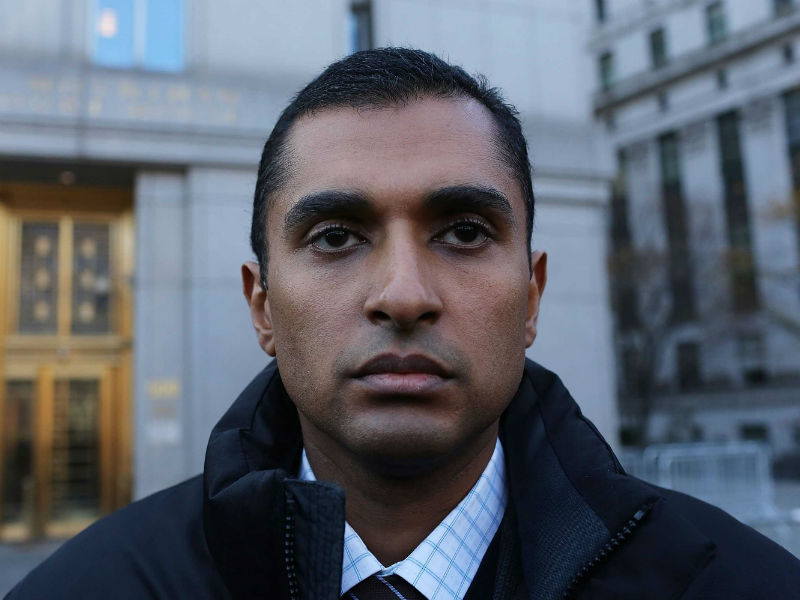
Matthew Martom, Image: Business Insider
Insider Trading- it is a “trade in shares or other securities (such as bonds or stock options) of a public company, carried out by those who have access to the company’s proprietary information. In a number of countries, trading based on insider information is considered illegal. ”
Matthew Martoma speculated on the shares of two companies: Elan and Wyeth. Both companies were developing a drug called Bapineuzumab or Bapi. They have invested hundreds of millions of dollars in creating Bapi and testing its use in the treatment of Alzheimer's . Due to the fact that the success of Elan and Wyeth in the development of Bapi was called into question, Matthew Martoma tried to find all possible information about the results of clinical trials.
For investors, finding information about the companies with which they do business is a standard procedure. Usually, search refers to reading publicly available material disclosed by companies. Matthew Martoma went far beyond that. He consulted with a doctor who was directly involved in conducting clinical trials, and was able to gain his trust. In July 2008, during their relationship, he learned (before the public announcement of Wyeth and Elan) that Bapi could not be a successful drug. A few days later, Matthew Martoma liquidated his $ 700 million position in both companies and continued to reduce it. During this process, his firm SAC earned $ 275 million in net profit.
Only 6 years after this success, Matthew Martoma is sentenced to 9 years in prison for insider trading. This is a rare case, as insider crime, as you know, is not easy to prove.
In cases of insider trading, two or more people exchange information. As a rule, they both benefit from the commission of such a crime, and therefore they have a serious motive to go unnoticed. In addition, insider trading participants are educated people. For example, Matthew Martoma studied at Harvard Law School and earned a degree in ethics. He had a good idea of what could be used against him and actively tried to defend himself. His mail and text messages to his boss Stephen Cohen contained brief instructions as they exchanged secret information verbally.
To prove guilt, Matthew Martomy committed insider trading by the Securities and Exchange Commission [Eng. The Securities and Exchange Commission, SEC ], which is the federal body responsible for regulating the securities industry, had to answer one question: how did Martoma access information about the Bapi trials? Finding such a connection is a difficult task. The SEC has access to numerous data, as it can arrange interviews and request information about phone calls and mail. The problem is how to find a hidden link among all this data?
How did the SEC build a graph and disclose insider trading plans?
When SAC Capital Advisors turned Bapi's unexpected failure statement into a major success, the SEC was informed. SEC investigators decided to find out how Stephen Cohen and his team could have such an uncanny ability to predict the future. They knew that something was wrong, but they could not prove anything.
That all changed when they studied the recording of a telephone conversation with Dr. Sid Gilman, an outstanding professor who participated in the Bapi trials. Dr. Sid Gilman spoke regularly with Matthew Martoma on the phone. And the SEC found a connection between Marta and the Bapi trials.
Of course, a few phone calls to prove it would not be enough. A more thorough investigation revealed that Martoma first contacted Dr. Gilman through GLG, which provided expert advice to the financial industry. Martoma gradually built a relationship with Dr. Gilman and obtained insider information to which he had access.
This led to a series of events that a month later resulted in a conference on the Bapi in Chicago in July 2008:
- Dr. Gilman sent an email to Martome with the subject “Some News,” since Elan and Wyeth made him responsible for presenting the results of Phase II clinical trials;
- After receiving a letter from Dr. Gilman, Martom arranged a consultation with him through the GLG to discuss “treatments for multiple sclerosis”;
- Dr. Gilman receives a PowerPoint presentation with the latest test results;
- Dr. Gilman and Martoma spent 105 minutes talking on the phone the day Dr. Gilman received a presentation with test results;
- During a visit to Ann Arbor, Martoma meets with Dr. Gilman and spends an hour with him before heading back to New York;
- Martoma makes a call on Cohen's Sunday phone and they talk for 20 minutes;
- Cohen and Martoma secretly sell off all Elan and Wyeth stocks;
- At an open conference in Chicago, Dr. Gilman announces the sad results of recent trials;
The SEC collected evidence, telephone records, emails, and computer-technical expertise data and restored the chain of events. It was probably a long and difficult process.
By chance or not, but the SEC created a graph. Using various data sources, she built a network of related events, people, dates, locations, or companies. She could accomplish this with the help of technologies using graphs.
Visual presentation of the case against Matthew Martoma
The SEC investigation began with intuition. Pharmaceutical companies have been involved in trials of a new drug called Bapi. SAC Capital Advisors traded their shares based on illegally obtained information. SAC Capital Advisors traded on Elan and Wyeth: is it legal? (by clicking the picture opens in full size) But how to prove the connection between the trading activities of SAC Capital Advisors and the set of illegally obtained information. If insider information was used, then who got it? From whom? To answer these questions, the SEC has selected several key figures who have a relationship with SAC Capital Advisors and the Bapi trials. The goal was to find a hidden connection. The main characters in the case (the picture is clickable)
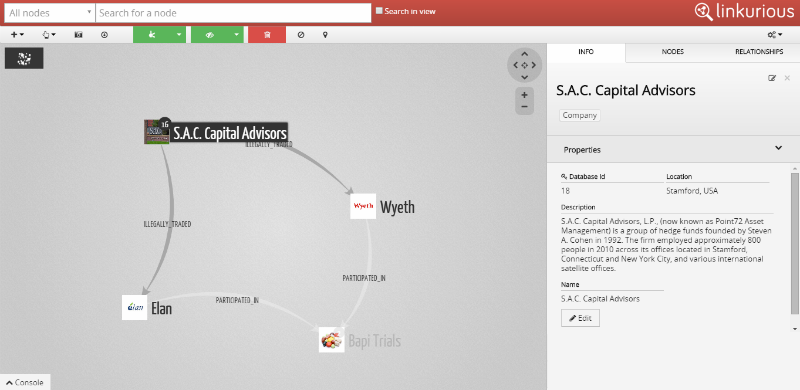

The graph above shows how each of several key actors relates to the SEC. Stephen Cohen was CEO of SAC Capital Advisors. He worked there with Matthew Martoma. Dr. Ross and Dr. Gilman participated in the Bapi trials, the first as a research physician and the second as a member of the Safety Committee in the trial.
Interestingly, we can see how SAC Capital Advisors are linked to clinical trials with the help of the Gerson Lehrman Group and Dr. Gilman. Gerson Lehrman Group is a company that provides hedge funds with access to specialists in a specific field. Dr. Gilman worked for the Gerson Lehrman Group, which in turn worked for SAC Capital Advisors. This is precisely the source of leaked information.
In order to understand how this leaked information was obtained, it is necessary to add to our column means of communication of our heroes.
Martoma received illegal information with the help of Dr. Gilman: Stephen Cohen received information from Martoma and used it to conduct transactions on the exchange: Gilman transmitted Martoma information that he had access to: Letters, meetings, phone calls: the participants in the case used various means of communication: The messages above are based on what picture the SEC was able to recreate during the investigation. It demonstrates how Matthew Martoma could receive insider information from Dr. Gilman, and how it was used to carry out the largest insider deal in history.
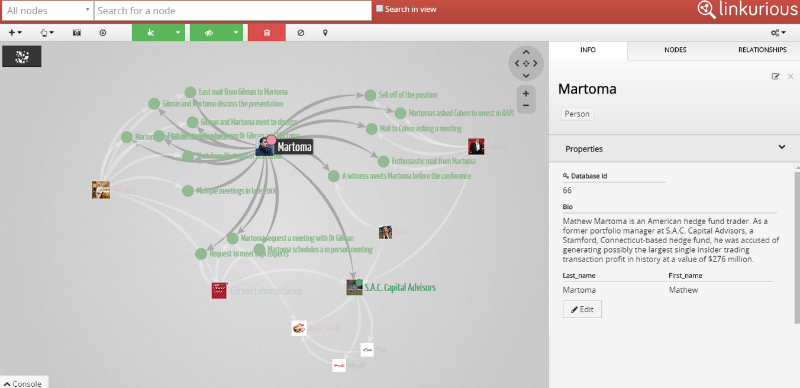
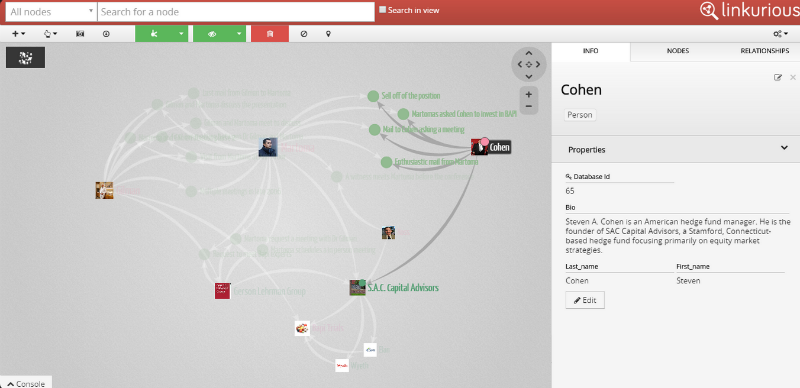
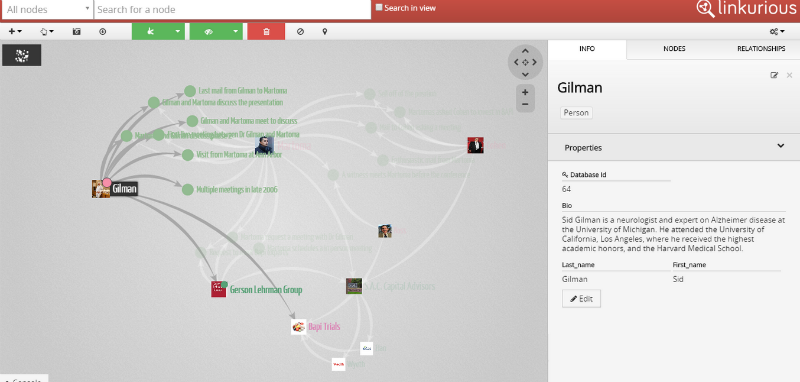

Why graphs are the foundation of complex data mining
To identify cases of insider trading, like most types of fraud, it is necessary to analyze a huge amount of data in order to find answers and guarantee the result (in the form of charges, confiscated funds, etc.).
The researcher must:
- process information from various sources (phone calls, testimonies, documents, mail, information from open sources, etc.);
- combine these sources to recreate a single "big picture";
- find key facts hidden in the data;
- to link different facts together into one convincing story.
Graphing technologies can facilitate this work:
- a graph is an ideal model for representing complex relationships associated with relevant data;
- graphing technologies are ideal for detecting subtle, indirect relationships between potential accomplices;
- A graphical visual representation is a great way to get to the core of the data and describe it.
Using a database-based graphing system, you can, for example, save records of phone calls, information from open sources (such as Facebook or Twitter), mail correspondence and other sources of relevant data within the same data model. Instead of working with multiple disparate data sources, the researcher can store all the necessary data in one place. A potential attacker may have a social network account, phone number or email address: if you put everything together, finding answers becomes easier.
To store the obtained data, graphing systems use databases as a basis. Building queries to such databases allows us to distinguish a clear structure in them. For example, a researcher may need to find out what communication facilities two potential suspects usually use. Using such tools, you can conduct such a search and find the answer in seconds. In addition, graph visualization is the best way to describe the result of complex research.
Investigating insider trading is confusing. Graphing technologies can speed up the process by allowing researchers to discover hidden links within large databases.
PS If you notice a typo, mistake or inaccuracy of the translation - write in a personal message, and we will quickly fix it.
PPS Recently, Russian citizens can easily buy shares of foreign companies (like Google, Apple, Facebook) - this opportunity appeared on the St. Petersburg Exchange .
